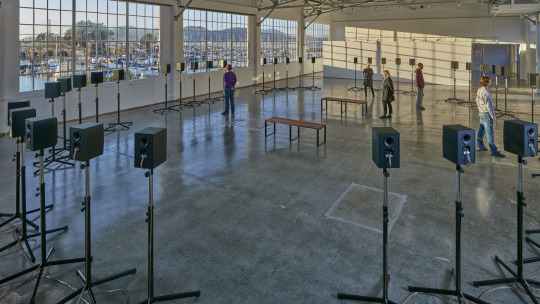
Sartle’s location at Fort Mason Center for Arts & Culture gives us the unique privilege of being surrounded by pretty much the coolest neighbors in San Francisco.
Last week, our across-the-way pal Gallery 308 opened for its inaugural exhibition, Janet Cardiff’s The Forty Part Motet. This piece is a spatial reenactment of Renaissance composer Thomas Tallis’s Spem in alium nunquam habui (I have never put my hope in any other). Cardiff recorded each part of the composition separately, using the singers from the Salisbury Cathedral Choir. Here’s my take:
To be honest, I was pretty stoked to have a break from writing a tricky review about an obelisk. What better way to get some fresh air than to check out one of our neighbors’ new shows?
I didn’t know much about the exhibition and was pleasantly surprised when I walked into a room with 40 speakers arranged in a circle. I was also pleasantly surprised that they let me in, because I wasn’t on the guest list and having a pretty bad hair day so I don’t look exactly qualified to get into anywhere remotely exclusive.

According to the brochure, “Tallis’s polyphonic masterpiece consists of eight choir groups, each of five vocal parts (soprano, alto, tenor, baritone, and bass). One voice begins and another joins. The voices emanate from the speakers, beckoning visitors to wander through the installation.” I was blown away by the beauty of the music as soon as I set foot in the space, but there wasn’t any sound coming out of the closest speaker so I figured I must be ‘doing it wrong’ and surreptitiously looked around to try to figure out how exactly the installation worked.
People stood between each speaker, rapt with attention. Some had their eyes closed. I moved in closer to try to catch an individual voice and the set of speakers behind me burst into song, an alto voice joined by the voice of a young boy. It took me back to my great-grandfather’s funeral in a small village in Wales, and the way that the tiny church reverberated with the impact of each hymn. From each speaker a distinct voice sang to us, allowing the listener to become embedded in the composition.

When the song ended, the gallery felt still with reverence. The woman next to me turned towards me and whispered plaintively, “I don’t want it to be over.”
In fact, many of the gallery’s visitors seemed to have set up camp permanently, their eyes still closed in rapture. The benches in the center of the room were packed tightly with people whose faces held expressions of unadulterated ecstasy. I would have stayed all day if I could have.
Instead, I decided to stay for the length of another song. As I waited for the system to reset, I noticed hushed voices coming from the speakers– a recording of background noise as the singers prepared to perform. The low murmuring was hardly perceptible and people leaned in with their ears against the speakers to catch each quiet conversation.
These mundane preparations for something so beautiful served to remind us that the singers are human: a thick English accent proclaiming “let’s rock” doesn’t have the majesty that you might expect. The inclusion of these moments brought even more intimacy to the exhibition, which was already unique in the way that it allowed us to express our emotional responses in such a public space. The second time through, a baby with one sock bobbed his head appreciatively to each Latin syllable. A man who appeared to have been there for a century swayed back and forth in the center of the room. People moved around the room gingerly, migrating from speaker to speaker. I felt like this:

If you have a moment to head over to Fort Mason and check out the exhibit, DO IT. Janet Cardiff is some kind of a genius.
By: Louisa Dewey









